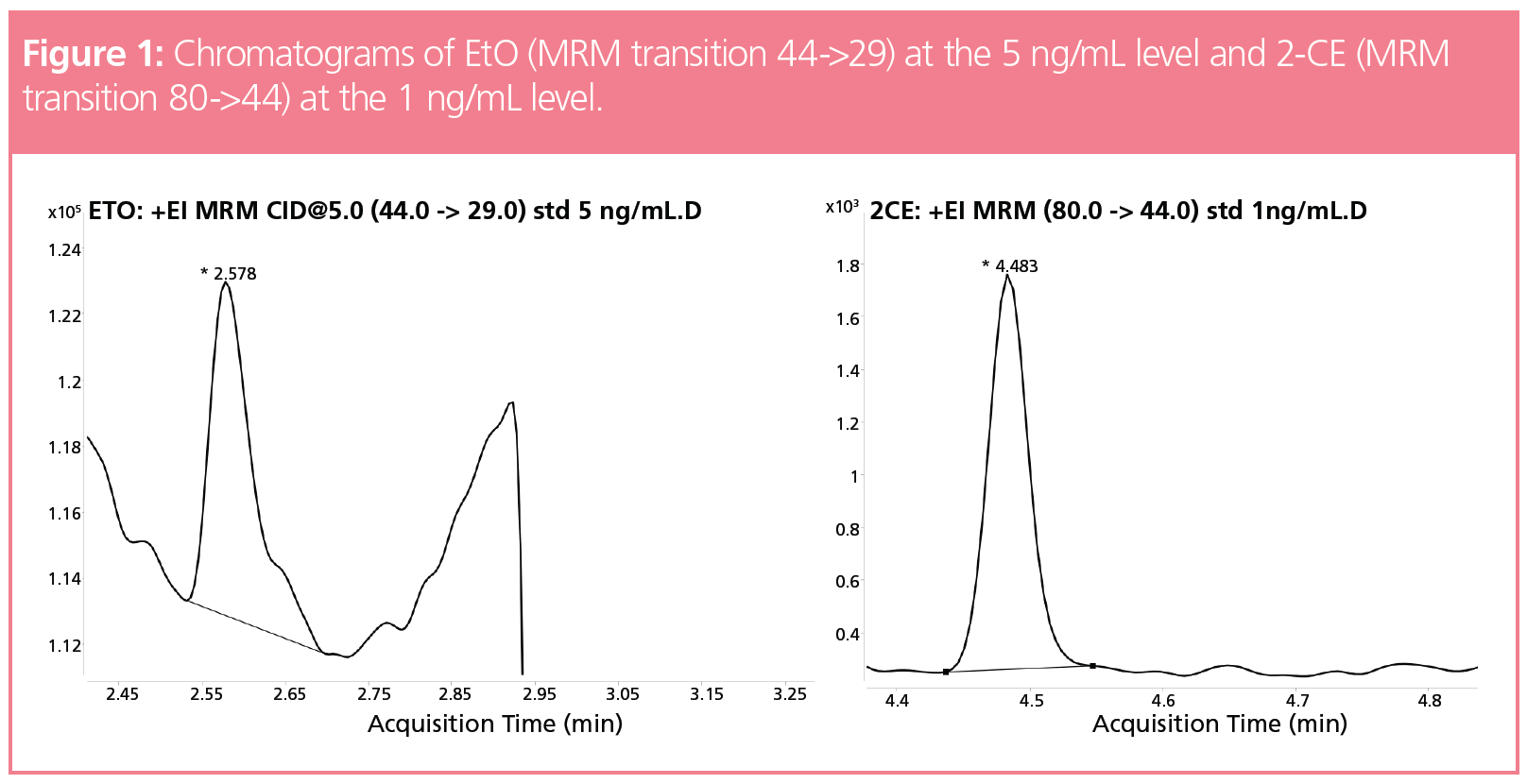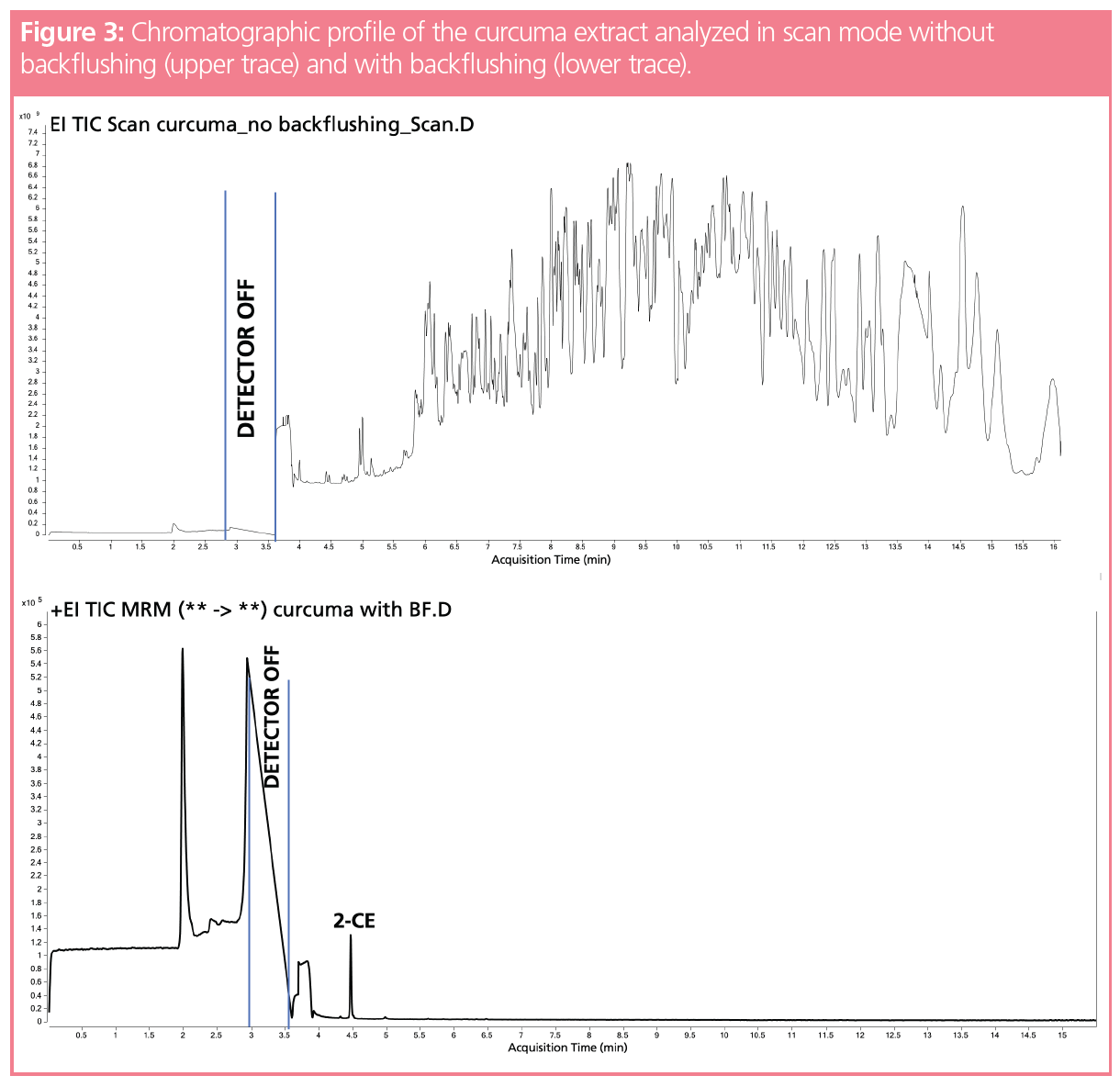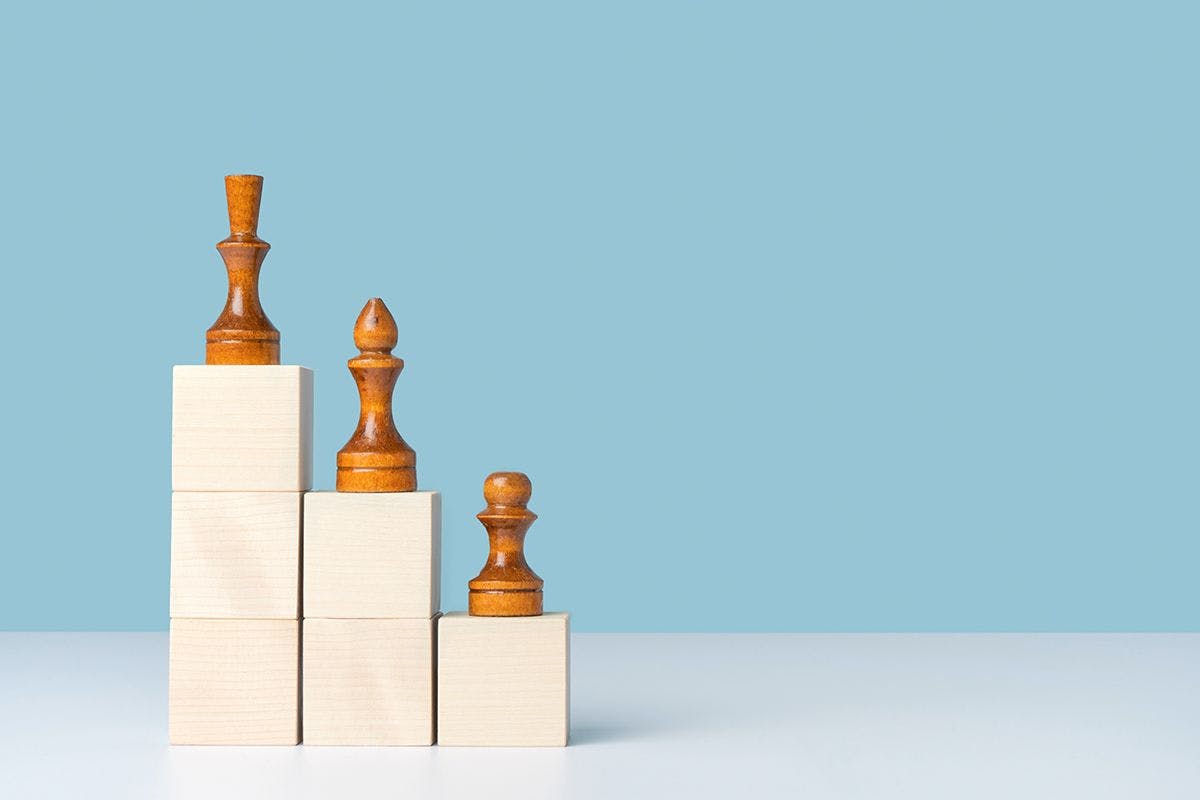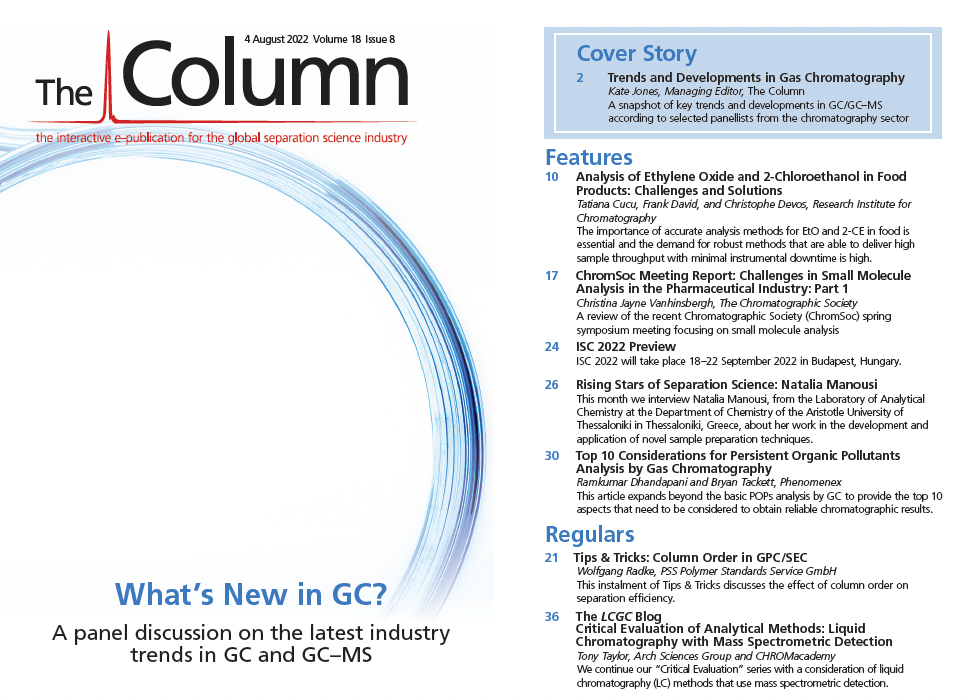Analysis of Ethylene Oxide and 2-Chloroethanol in Food Products: Challenges and Solutions
Ethylene oxide (ETO) and its metabolite 2-chloroethanol (2-CE) represent a new emerging food safety issue, with significant product recalls and more than 800 notifications on the EU RAFSS portal. Determination of these contaminants is presented based on the EURL Single Residue Method (SRM) involving QuEChERS (quick, easy, cheap, effective, rugged, and safe) extraction and gas chromatography–tandem mass spectrometry (GC–MS/MS) analysis. Increased robustness and productivity were achieved by automated replacement of the GC inlet liner to prevent accumulation of nonvolatile material from the QuEChERS extracts and by integration of precolumn backflushing. ETO and 2-CE were determined at low µg/kg range in QuEChERS extracts of sesame seeds and the spice curcuma.
Ethylene oxide (EtO) is a disinfectant that was initially allowed for use in food based on its proven capacity to protect against fungi, viruses, and bacteria. However, it has been banned in the EU as a pesticide since 1991 due to its classification as a category 1 carcinogen by the International Agency Research of Cancer (IARC) (1). Due to its effectiveness as fumigant, it is currently still in use for container fumigation in some countries. In September 2020, Belgium added a notification on the EU Rapid Alert System for Food and Feed (RASFF) concerning EtO residues in sesame seeds originating from India. The detected levels substantially exceeded the maximum residue level (MRL) of 0.05 mg/kg for sesame seeds set by Regulation (EU) 2015/8681 (2). The discovery of so many cases of illegal fumigation of sesame seeds with EtO triggered a wave of demand for the analysis of EtO in food, which ultimately caused numerous withdrawals and recalls of both conventional and organic products in many EU member states. In addition, the EU Commission issued Regulation (EU) 2020/1540, which required 50% of sesame shipments originating from India to be tested for ethylene oxide (3). Even though the focus was initially on sesame and products thereof imported from India, it was rapidly seen that EtO is a relevant issue for other food categories as well. By June 2022, over 850 notifications related to the occurrence of EtO, mostly in seeds and spices, have been registered on the RASFF portal. In 2015, the EU-MRLs for spices were lowered to 0.1 mg/kg. At the same time, the MRLs for nuts, oil fruits, and oil seeds were set at 0.05 mg/kg (2). To enforce these regulations, accurate analysis methods for these contaminants in food are essential, and the demand for robust methods that are able to deliver high sample throughput with minimal instrumental downtime is high.
Experimental
Both EtO and 2-CE may occur in food samples. The 2-CE metabolite, however, predominates, mainly because it is less volatile than EtO. As a result, simultaneous determination of both analytes in a single method is recommended. In addition, a dedicated method for quantification of EtO and 2-CE is preferred, rather than integrating the analytes into an existing multiresidue pesticides method.
Various methods for the analysis of EtO, or the sum of EtO and 2-CE, have been published. Some of these methods are based on the conversion of 2-CE to EtO under alkaline conditions—an approach that was later optimized and used as an official standard method in Germany (4). Other methods are based on the conversion of the EtO to 2-CE under acidic conditions, followed by extraction of 2-CE with ethyl acetate and analysis by gas chromatography–mass spectrometry (GC–MS). However, these methods are time‑consuming, labour-intensive, and require the use of large quantities of harmful solvents. Sample preparation is essential in the analysis of EtO and 2-CE. Therefore, in December 2020, EU Reference Laboratories for Residues of Pesticides recommended a single-residue method for the analysis of EtO and 2-CE in sesame seeds that uses QuEChERS (quick, easy, cheap, effective, rugged, and safe) extraction followed by GC–MS/MS analysis (5). The QuEChERS-based GC method as applied in this study involved three steps:
- Extraction (2–5 g sample) using an organic solvent and salt-assisted partitioning;
- Sample clean-up with adsorbent materials (dispersive sorbents); and
- GC–MS/MS analysis using a dedicated 30 m × 0.20 mm, 1.12 µm HP-VOC column (Agilent Technologies).
The analysis system consisted of a multipurpose sampler MPS with automated liner exchange (ALEX) option fitted to a cooled injection system (CIS 4) PTV-type inlet (all from Gerstel), mounted on a GC 7890/7010B triple quadrupole GC–MS/MS system with high-efficiency source (HES) and with capillary flow technology (CFT) option for precolumn backflushing (all from Agilent Technologies).
Optimal injection conditions are needed to ensure a good peak shape for EtO. The PTV‑type GC inlet was used to perform cold split injection of samples, and a well‑controlled evaporation process allowed for reproducible and accurate injection and therefore optimal results for the target analytes.
Results and Discussion
Figure 1 shows the chromatograms for EtO at 5 ng/mL level (equivalent to 25 µg/kg sample level) and 2-CE at 1 ng/mL level (equivalent to 5 µg/kg sample level), which are well below the EU-MRL levels for spices and sesame seeds.

Acetaldehyde is often present in food products, particularly in those that are fatty. Because acetaldehyde and EtO have very similar mass spectra and retention indices, there are essentially no multiple reaction monitoring (MRM) transitions available to select for EtO if it coelutes with acetaldehyde. Therefore, it is essential to prevent their coelution during analysis. On the selected column, acetaldehyde eluted just before EtO and baseline separation was achieved.
EtO was quantified using calibration curves ranging from 5 to 100 ng/mL, and 2-CE was quantified using calibration curves ranging from 0.84 to 84 ng/mL using EtO-d4 and 2-CE d4 as internal standards, respectively. The R2 value was greater than 0.99 for both target compounds (Figure 2), indicating
excellent linearity.

Food and feed matrices are extremely complex and contain many interfering compounds that can lead to ion suppression effects, coelution, and severe contamination of the analytical instrumentation from injector to detector. To determine the chromatographic stability of the method, extracts of sesame seed and curcuma spiked with EtO and 2-CE were injected repeatedly from the same vial into the same liner. Activity in the liner caused about 40% reduction in peak area of 2-CE after several repeated injections, and peak distortion occurred after injection of extracts containing interfering compounds, such as present in curcuma. This distortion demonstrated that injection of relatively dirty QuEChERS extracts was likely to negatively impact analysis accuracy. The GC liner was exchanged after a user‑defined number of injections to limit the amount of nonvolatile material accumulating in the liner.
To further prevent high-boiling point compounds from reaching the analytical column and contaminating the MS ion source, a precolumn backflushing option was used. Figure 3 shows the full-scan analysis of a curcuma extract performed without backflushing, demonstrating the complexity of the injected food samples. Without precolumn backflushing, the injected matrix material inevitably reaches the analytical column and ultimately the MS ion source. When starting the precolumn backflush immediately after the transfer of the target analytes to the analytical column, only very small amounts of sample matrix gained access to the column, allowing for the analysis of more samples before maintenance was required compared to a conventional setup.

The method was validated by performing recovery experiments in triplicate at three different concentrations: 0.05, 0.2, and 0.5 mg/kg sample, respectively. The recovery was in the range of 84.5 to 100.6% for EtO, and 88.8 to 106.2% for 2-CE in blank sesame and curcuma samples (Table 1).

Finally, representative food samples collected in a local supermarket were analyzed using the developed method (Table 2). None of the samples tested positive for EtO, probably because the samples—some of which had even been thermally treated—were collected in shops. However, in border control programmes for example, under the correct sampling and storage conditions, it can not be excluded that significant amounts of EtO would be detected. All samples tested positive for 2-CE, some at levels above the MRL values for these commodities.

Conclusions
The optimized method based on QuEChERS extraction followed by GC–MS/MS analysis with liner exchange and precolumn backflushing option provided reliable results and excellent performance, demonstrating that the method can be used to quantify EtO and 2-CE in sesame and spice samples at the EU regulated levels. The method has the advantages of high sensitivity, selectivity, accuracy, and sample throughput due to reduced downtime for inlet maintenance, analytical column exchange, and MS ion source cleaning.
References
- F. Tateo and M. Bononi, Journal of Food Composition and Analysis 19, 83–87 (2006).
- Regulation (EU) 2015/868 of 26 May 2015 amending Annexes II, III, and V to Regulation (EC) No 396/2005 of the European Parliament and of the Council as regards maximum residue levels for 2,4,5-T, barban, binapacryl, bromophos-ethyl, camphechlor (toxaphene), chlorbufam, chloroxuron, chlozolinate, DNOC, di-allate, dinoseb, dinoterb, dioxathion, ethylene oxide, fentin acetate, fentin hydroxide, flucycloxuron, flucythrinate, formothion, mecarbam, methacrifos, monolinuron, phenothrin, propham, pyrazophos, quinalphos, resmethrin, tecnazene, and vinclozolin in or on certain products, Off. J. Eur. Union L 145/1–71 (2015).
- Commission Implementing Regulation (EU) 2020/1540 of 22 October 2020 amending Implementing Regulation (EU) 2019/1793 as regards sesamum seeds originating in India, Off. J. Eur. Union L 353/4-7 (2020).
- K.G. Jensen, Z. Lebensm. Unters Forsch 187, 535–540 (1988).
- EURL-SRM-Analytical Observation Report, Analysis of Ethylene Oxide and its metabolite 2-Chloroethanol by the QuOil or the QuEChERS method and GC–MS/MS (December 2020).
Tatiana Cucu received her Ph.D. degree in the field of food safety and food quality in 2011 at the University of Ghent, Belgium. During her Ph.D. and later during her postdoc, she developed analytical methods for the analysis of food allergens and food additives. In 2015, she joined the Research Institute for Chromatography (RIC) as Senior Scientist where she is involved in projects related to the development and optimization of GC–MS and GC–MS/MS methods, miniaturization, and automation of sample preparation methods, and the development of new applications for the food, environmental, pharmaceutical, and chemical industries.
Frank David received his Ph.D. degree in 1986 at the Laboratory of Organic Chemistry of the University of Ghent. Since October 1986, he has been Principal Scientist at RIC. He is author of more than 100 scientific papers in different areas of separation science. His expertise includes capillary gas chromatography, supercritical fluid chromatography (SFC), GC–mass spectroscopy (GC–MS), high performance liquid chromatography (HPLC), liquid chromatography–mass spectroscopy (LC–MS), multidimensional chromatography (GC–GC, GC×GC, LC–GC), miniaturization, and automation of sample preparation.
Christophe Devos received his Ph.D. degree in analytical chemistry in 2007 from the University of Ghent. He then joined the RIC group in 2005, where he was initially involved in the development and automation of novel sample preparation methods for gas chromatographic analysis. He presently occupies the position of Senior Scientist/Project Manager within the RIC Technologies group, developing and supporting new analytical solutions and important market applications.
E-mail: tatiana.cucu@RIC-group.com
Website: www.RIC-Group.com

Analytical Challenges in Measuring Migration from Food Contact Materials
November 2nd 2015Food contact materials contain low molecular weight additives and processing aids which can migrate into foods leading to trace levels of contamination. Food safety is ensured through regulations, comprising compositional controls and migration limits, which present a significant analytical challenge to the food industry to ensure compliance and demonstrate due diligence. Of the various analytical approaches, LC-MS/MS has proved to be an essential tool in monitoring migration of target compounds into foods, and more sophisticated approaches such as LC-high resolution MS (Orbitrap) are being increasingly used for untargeted analysis to monitor non-intentionally added substances. This podcast will provide an overview to this area, illustrated with various applications showing current approaches being employed.













